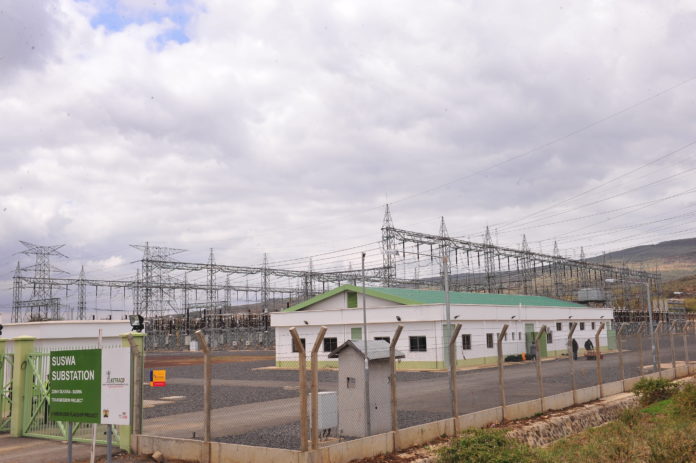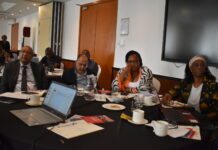By Nanjinia Wamuswa
The Kenya Electricity Transmission Company (Ketraco) energized first of its kind 400kV transmission line in Kenya and East African region yesterday evening at Suswa sub-station.
His Excellency President Uhuru Kenyatta commissioned the Mombasa-Nairobi and Suswa-Isinya transmission lines.
Cabinet Secretary of Energy and Petroleum Hon Charles Keter revealed that at 482km and 440kV, the Mombasa–Nairobi Transmission line is the longest and highest voltage line that East Africa has ever seen.
President Uhuru Kenyatta commissions the Mombasa-Nairobi and Suswa-Isinya transmission lines, a project initiated by Kenya Electricity Transmission Company (Ketraco) yesterday evening at Suswa sub-station in Narok County. On the (left) is Cabinet Secretary for Energy and Petroleum Hon Charles Keter. PHOTO BY NANJINIA WAMUSWA
“It has a transfer capacity of 1,500MW, which is only 200MW less than the current national demand that stands at 1,700MW. Furthermore, the capacity of this line today is equivalent to 19 times the capacity of the old line built in 1969, whose capacity back then was 80MW. This is indeed a great milestone for Kenya,” he said.
Hon. Keter said the Mombasa-Nairobi and Suswa-Isinya transmission lines will improve transfer capacity of electrical energy as well as address the challenge of low voltages, high transmission losses, and unreliability of supply and network security.
At the same time, the two lines will also strengthen the national grid system and enhance capacity.
He lauded: “The transmission lines are one of the most environmentally clean lines as it is purely hydro-powered. This is in line with the government’s clean energy initiative, which slices our electricity bills by half and saves on Government expenditure.”
For the first time in Kenya, a 220kV underground cable was constructed from the Nairobi National Park to Embakasi substation in order to avoid the flight path of the Jomo Kenyatta International Airport.
Ketraco Managing Director Mr. FCPA Fernandes Barasa is optimistic the Mombasa-Nairobi transmission line and the Suswa-Isinya transmission line would provide accelerated opportunities for investors and additional investment in power such as the generation of solar, wind, geothermal, coal and gas sources.
Mr. Barasa urged investors to take advantage of the project and partner with Ketraco in the transmission of the generated power.
“With the facilitation of a 24-hour economy that enhances security, we shall soon witness the setting foot of larger numbers of manufacturers in this county, more businesses will extend their working hours thereby creating new jobs, hospitals will invest in better machinery that will take care of the unwell, and learning institutions will be able to invest in high-end equipment for their laboratories thus producing bright students and all these will give rise to a stable economy. With a stable economy, the county will rid itself of vices caused by unemployment,” he said.
The Chairman of Ketraco Board of Directors, Dr. Kenneth Sigilai, emphasized Ketraco’s interest to ensure that the Government’s promise of availing adequate power at affordable tariff by the year 2030 and ensuring all Kenyans have access to electric power comes to fruition.
“In future the Suswa-Isinya transmission line will enable Kenya, Uganda, Tanzania, South Sudan, Rwanda, Democratic Republic of Congo and Burundi to harness economic power surplus available in different countries throughout the year. The line will also act as a major connection point of the wind power from Turkana which upon termination at Suswa will be transmitted to Nairobi thus offering an alternative to hydro and geothermal power during peak demands,” added Dr. Sigilai.

According to Hon. Keter, approximately Sh 3.6 billion annually will be potentially saved by power consumers from the reduced fuel cost component in individual bills once we switch off thermal power generation plants at the Coast.
This will add to the annual savings of Sh1 billion, which is Sh 250 million from Lamu and Sh 750 million from Garissa that materialized when we connected Lamu and Garissa to the grid by switching off the stand-alone generators
He added that Mombasa-Nairobi transmission line will greatly boost power transfer capacity between Mombasa and Nairobi by replacing the existing 66kV power line, which has been frequently subjected to various challenges including vandalism, marine pollution and scavenger birds that weaken the wires leading to frequent line breakage and short circuiting the line.
Hon Keter explained: “The proposed Special Economic Zones in Mariakani and Voi areas will get reliable power. Also the Mombasa-Nairobi transmission line will be used to electrify the Standard Gauge Railway once it switches to electric power.”
Ketraco General Manager, Technical Services Eng. Joseph Siror explained that Suswa-Isinya transmission line will facilitate international power trade between Ethiopia, Kenya, Tanzania and Southern Africa.
“This will be achieved through creating a connection at Isinya that will supply Tanzania and the connection at Suswa that will supply Ethiopia after completion of the Ethiopia-Kenya interconnector (or the Eastern Electricity Highway),” he said.
Eng. Siror added the same Suswa-Isinya line will also act as a major connection point of the wind power from Turkana which, upon termination at Suswa, will be transmitted to Nairobi and other parts of Kenya.
The Coast will be a major beneficiary through the Mombasa-Nairobi transmission line as it will offer an alternative to hydro and geothermal power during peak demands.
The Sh 20 billion Mombasa-Nairobi transmission line project was sponsored by the government of Kenya, the African Development Bank (AfDB), the French Development Agency (AFD) and the European Investment Bank (EIB).
And the funding for the Suswa-Isinya transmission line came from the government of Kenya, the French Development Agency (AFD) and the European Investment Bank (EIB) at the cost of Sh 5.5billion.















